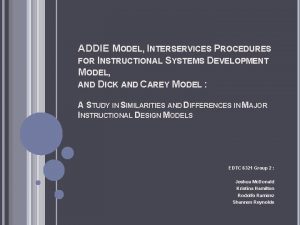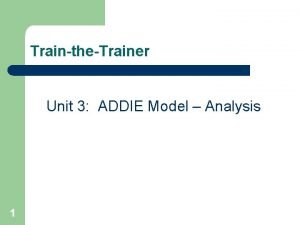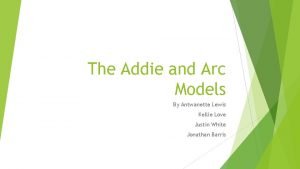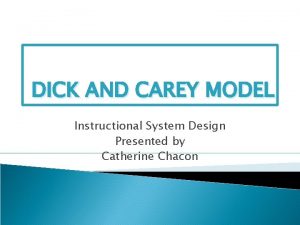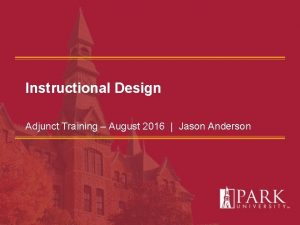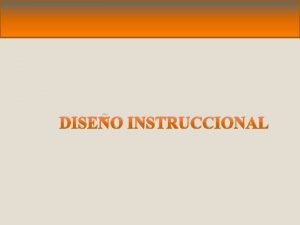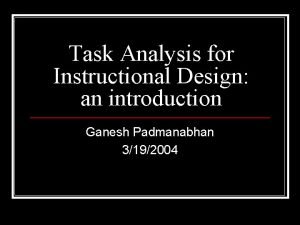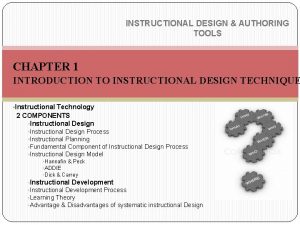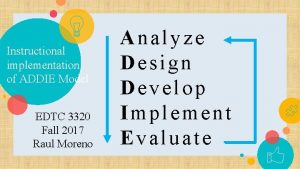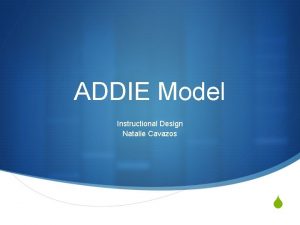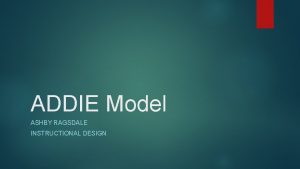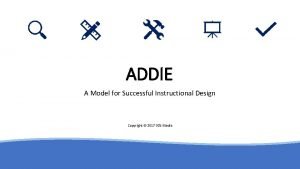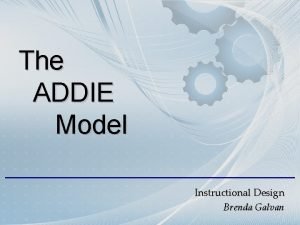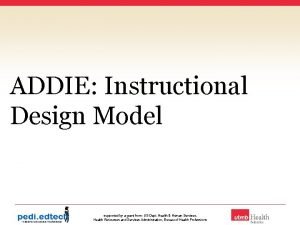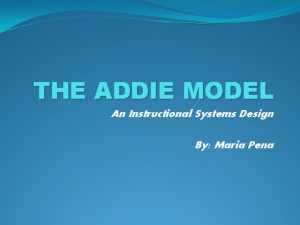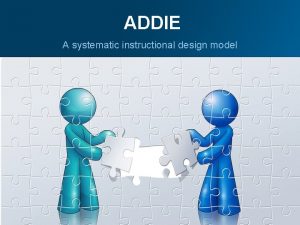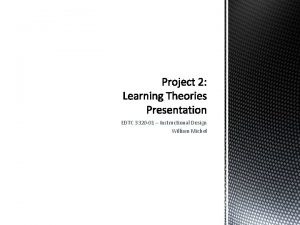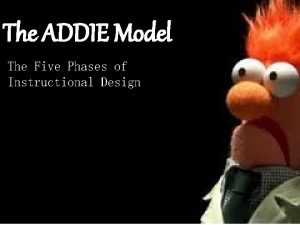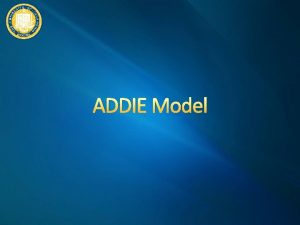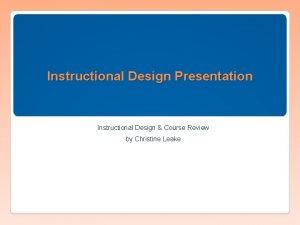ADDIE Model Presentation 3320 Instructional Design for the























- Slides: 23

ADDIE Model Presentation 3320: Instructional Design for the Corporate Trainer Professor Matt Crosslin, M. Ed. By: Carmen e. Gonzalez

What is the ADDIE Model? • Standard process for developing online learning courses used by instructional designer • Basic guideline for creating effective and efficient educational, informative, and often times entertainment driven learning • Consists of five phases; • Analysis • Design • Development • Implementation • Evaluation

What is ADDIE’s history? • Florida State University creates ADDIE Model for use with U. S. Army • Most used version of ADDIE Model came to fruition in the mid-80 s • In 1985, ADDIE is first used as acronym (Schlegel, 1995) • Since its boom in the mid-80 s other models such as, the Dick & Carey and Kemp ISD have surfaced • Most recently an updated version of ADDIE, Rapid Prototyping has become popular in the world of design.

Five Stages of ADDIE Model An Instructional Designer builds online learning through the process of the ADDIE Model by working through the phases below: • Analysis • Design • Development • Implementation • Evaluation

Analysis This phase requires extra attention, as it is the vision of the “Dream Home”, or course in this case.

Analysis • The most essential of all of the ADDIE Model steps. • Can be daunting involving investigative skills to research and interview audience and Subject Matter Expert(s) (SMEs). • Equivalent to homeowners shopping for home builders. • The building of a “Dream Home” is entrusted to the selected architect, just as course development is entrusted to the Instructional Designer.

Analysis Assessing the want for a course versus the need for the course will ensure the development will be delivered on time and effective for the learners. Knowing what is expected of the course before designing the course helps establish a strong foundation for applying the other phases of the ADDIE Model.

Analysis The following are a small sample of questions to ask during the Analysis phase of the ADDIE Model: • • • • Why is this course important? What are the objectives for the course? Who is your SME (Subject Matter Expert)? Who is your audience? How many people will be accessing this course? Are performance reviews affected according to the course grade? What is the audience’s learning curve? Is your audience lacking skills that need to be learned or enhanced? How receptive is your audience to change? At what level does this change need occur? What does your audience already know? What are the demographics of your audience? Are there cultural barriers that may affect delivery or learning? What impact will this course have on their attitudes about their job or the environment in which they work?

Design The blueprint for the SMEs dream course is now in place. It’s time to pour the foundation.

Design Now that the data for the courses vision has been collected, it is time to apply that information in a logical and creative way.

Design This phase, called DESIGN in the ADDIE Model consists of the following three components: • Provide an Outline • Encourage a Review • Insist on Approval

Design Provide an Outline • Gives a concrete view of how the course will develop • Eliminates future headaches when other ideas or suggested as last minute ‘fixes’ • The blueprint

Design Encourage a Review • This provides a feedback process that encourage dialogue and collaboration for a better product with the SME(s) and often times the end-user. • Proceeding to the development phase without this review could result in having to tear down walls, move plumbing or rewire the course altogether leading to costly and ineffective training.

Design Insist on Approval • This might seem ‘petty’ to some, but making the SME(s) accountable for approving their vision is important to save time and money. • Providing a version control form during the Approval stage can give the SME(s) the necessary confidence to know that the course will need maintenance well after the implementation and evaluation phases.

Development Building the course to meet audience and SME(s) specifications can be insightful and exciting.

Development This phase provides the inner workings of course from the Introduction page to the details of each quiz or Interactivity. Much like the Architect works with the Construction Crew, the painters, Interior Designers and Landscapers, so does the Instructional Designer work with Graphic Artists, Information Technology, Copywriters, etc. , yet often times alone pulling from their skills, to bring to life each and every element of the overall course.

Development Much like the use of some of the following tools enhance and give a course its dynamic and edutainment appeal, so the Architect seeks out skilled individuals to add vibrancy and flare to the sound structure they’ve built through the Analysis and Design phases. • • Dreamweaver, Flash, Soundbooth, Media software, etc. Word, In. Design, Desktop Publishing software, etc. Photoshop, Fireworks, Paint, etc. Flash Media Server, database applications, etc.

Development This is the basic inspection before the end-user, homeowner will be given the keys to the “Dream Home” (course).

Implementation Making sure the design and delivery of the final product is reflective of the original vision.

Implementation Checking to ensure that the solid foundation also has an interesting and easy to navigate interior is necessary for meeting the learner’s needs.

Evaluation Follow-up and maintenance are crucial requirements to ensure that the course meets the needs of the learner.

Summary • The ADDIE Model is most used for its simplicity and accuracy when followed in the correct order. • There are newer models being developed to meet time and financial restraints, however they diminish the quality of the course when too much is downsized. • Reusing and recycling media in creative ways saves time and money without sacrificing the interactivity that so many learners require nowadays.

References • Schlegel, M. J. (1995). A Handbook of Instructional and Training Program Design. ERIC Document Reproduction Service ED 383281. • http: //www. instructionaldesignexpert. com/design_phas e. html • http: //www. nwlink. com/~donclark/history_isd/addie. ht ml • http: //www. instructionaldesign. org/models/addie. html
 Bis 3320
Bis 3320 Addie carey
Addie carey Model addie dalam bahasa melayu
Model addie dalam bahasa melayu Addie model lesson plan for math
Addie model lesson plan for math Model addie dalam pendidikan islam
Model addie dalam pendidikan islam Model addie dalam pendidikan islam
Model addie dalam pendidikan islam Addie model example lesson plan
Addie model example lesson plan Addie model example
Addie model example Arcs model
Arcs model Model berorientasikan bilik darjah
Model berorientasikan bilik darjah Dynamic instructional design model
Dynamic instructional design model Impact of assure model to students
Impact of assure model to students Jerrold kemp
Jerrold kemp Dick carey model
Dick carey model Assure model of instructional design
Assure model of instructional design Sam instructional design
Sam instructional design Kemp's instructional design model
Kemp's instructional design model Ejemplos de modelo addie
Ejemplos de modelo addie Addie mudel
Addie mudel Instructional design nedir
Instructional design nedir Addie mudel
Addie mudel Task analysis instructional design
Task analysis instructional design The diamond model of curriculum development
The diamond model of curriculum development Instructional design authoring tools
Instructional design authoring tools






